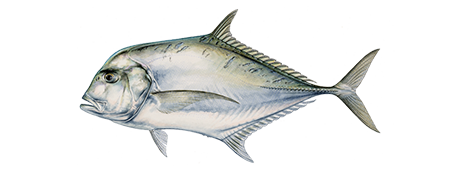
African Pompano
The African pompano is the largest and most widespread species of the genus Alectis. The adult specimens are large, vertically flattened fish with bright pearlescent sides and the head is distinctively blunt.

Region
South, Northeast
Catch ease
Medium
Habitat
Bay, Ocean
How to identify an African Pompano
African pompano can be distinguished from other members of the genus by the lower number of gill rakers on the first branchial arch. These fish are characterized by 4-6 elongated, thread-like rays in the front part of the second dorsal and anal fins. In juveniles the first two of these rays may be four times as long as the fish. Normally, the rays tend to disappear or erode away as the fish grows. The fish also undergoes changes in body shape as it grows. The body of the juvenile fish is short and deep.
The spines of the first dorsal fin are visible, though not very prominent at this stage. By the time the fish is 14 inches long, the body is more elongated and the forehead is steeper. In both juveniles and adults the body is strongly compressed. The lateral line arches smoothly but steeply above the pectoral fins. Large specimens are light bluish green above and silvery over most of the remainder of the body.
Where to catch African Pompano
It can be found from New Jersey south through Florida and into the Gulf of Mexico.
The following list includes additional details on where to catch African pompano:
| Baitfish Patches |
| Channel Entrances |
| Jetties and Breakwaters |
| Merging Water |
| Reefs, Wrecks, and Shoals |
| Bays and Estuaries |
| Coastal Waters |
| Man-Made Structures |
| Piers, Docks and Pilings |
| Schools |
How to catch African Pompano
The African pompano is not actually a member of the pompano family and is more closely related to a jack. It is a strong fighter and an excellent light tackle game fish. It will take small live or dead baits, as well as lures, jigs and feathers. It is usually caught incidentally while trolling for other species.
Most anglers who specifically target these fish will seek them out over offshore wrecks using live bait and jigs. The fish can sometimes be chummed up close to the surface using live bait and targeted with fly tackle however this is a more difficult approach.
The following are fishing methods used to catch African pompano:
| Drift Fishing |
| Bottom Bouncing |
| Surf Casting |
| Spin Casting |
| Saltwater Jigging |
| Fly Fishing |
| Bait Casting |
| Still Fishing |
| Saltwater Trolling |
African Pompano lures, tackle & bait
The following are fishing lures, tackle and bait that can be used to catch African pompano:
